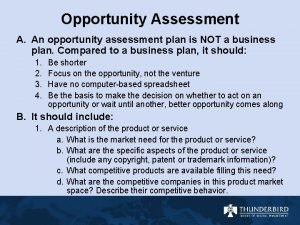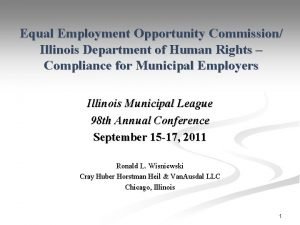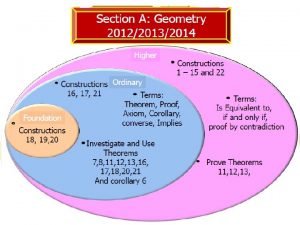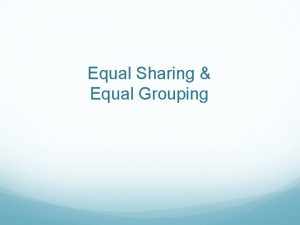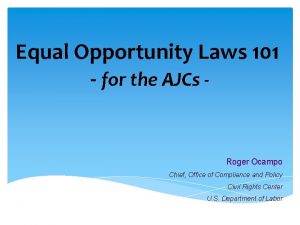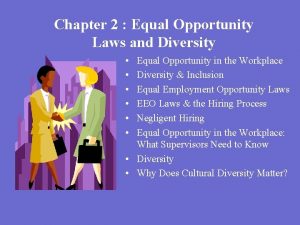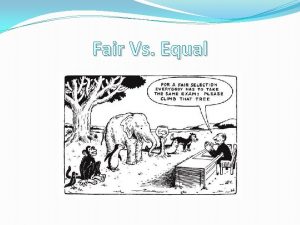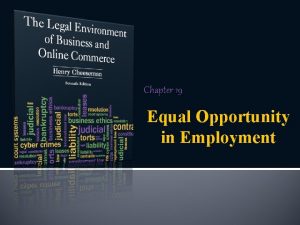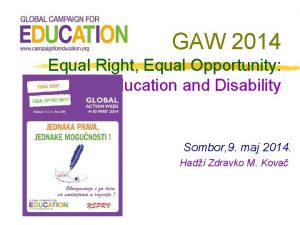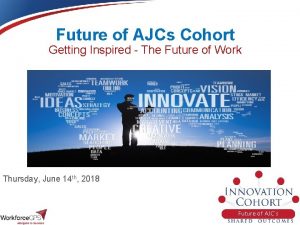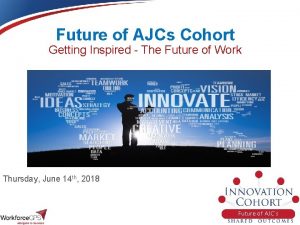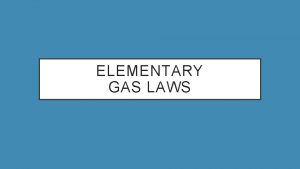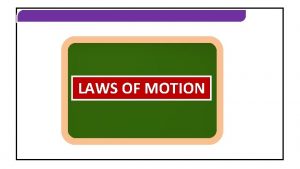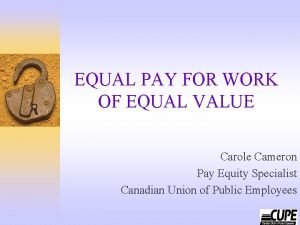Equal Opportunity Laws 101 for the AJCs Roger














































- Slides: 46

Equal Opportunity Laws 101 - for the AJCs - Roger Ocampo Chief, Office of Compliance and Policy Civil Rights Center U. S. Department of Labor

Civil Rights Center The mission of the Civil Rights Center is to promote justice and equal opportunity by acting with impartiality and integrity in administering and enforcing various civil rights laws. These laws protect: Department of Labor employees and applicants for employment, and Individuals who apply to, participate in, work for, or come into contact with programs and activities that are conducted by or receive financial assistance from DOL, or, under certain circumstances, from other Federal agencies. We carry out this mission by investigating and adjudicating discrimination complaints, conducting compliance reviews, providing technical assistance and training, and developing and publishing civil rights regulations, policies, and guidance. 2

Common Thread …be excluded from participation in, denied the benefits of, subjected to discrimination under, or denied employment… 3

Civil Rights Act of 1964 An Act to enforce the constitutional right to vote, to confer jurisdiction upon the district courts of the United States to provide injunctive relief against discrimination in public accommodations, to authorize the Attorney General to institute suits to protect constitutional rights in public facilities and public education, to extend the Commission on Civil Rights, to prevent discrimination in federally assisted programs, to establish a Commission on Equal Employment Opportunity, and for other purposes. 4

Parts of the Civil Rights Act Important to AJCs Title II Injunctive Relief Against Discrimination in Public Accommodations race, color, religion or national origin Title III Desegregation of Public Facilities race, color, religion or national origin Title IV Desegregation of Public Education race, color, religion or national origin Title VI Nondiscrimination in Federally Assisted Programs race, color, religion or national origin Title VII Equal Employment Opportunity race, color, religion, sex or national origin 5

Rehabilitation Act of 1973 An act to replace the vocational rehabilitation act, to extend and revise the authorization of grants to states for vocational rehabilitation services, with special emphasis on services to those with the most severe handicaps, to expand special federal responsibilities and research and training programs with respect to handicapped individuals, to establish special responsibilities in the secretary of health, education, and welfare for coordination of all programs with respect to handicapped individuals within the department of health, education, and welfare, and for other purposes. 6

Parts of Rehabilitation Act of 1973 Important to AJCs Section 503 requires affirmative action and prohibits employment discrimination by Federal government contractors and subcontractors with contracts of more than $15, 000. Section 504 provides opportunities for children and adults with disabilities in education, employment and various other settings. It allows for reasonable accommodations such as special study area and assistance as necessary for each student. 7

Focus on Section 504 Each Federal agency that provides Federal financial assistance also has section 504 regulations. Requirements common to these regulations include: reasonable accommodation for beneficiaries and employees with disabilities; programmatic accessibility; effective communication with people who have hearing or vision disabilities; and accessible new construction and alterations. Section 504 may also be enforced through private lawsuits. It is not necessary to file a complaint with a Federal agency or to receive a "right-to-sue" letter before going to court. 8

Age Discrimination Act of 1975 Title III - 42 USC 6101 Section 6101. Statement of purpose - It is the purpose of this chapter to prohibit discrimination on the basis of age in programs or activities receiving Federal financial assistance. Section 6102. Prohibition of discrimination - Pursuant to regulations prescribed under section 6103 of this title, and except as provided by section 6103(b) of this title and section 6103(c) of this title, no person in the United States shall, on the basis of age, be excluded from participation in, be denied the benefits of, or be subjected to discrimination under, any program or activity receiving Federal financial assistance. 9

Education Amendments of 1972 To amend the Higher Education Act of 1965, the Vocational Education Act of 1963, the General Education Provisions Act (creating a National Foundation for Postsecondary Education and a National Institute of Education), the Elementary and Secondary Education Act of 1965, Public Law 874, Eighty-first Congress, and related Acts, and for other purposes. 10

Part of Education Amendments Important to AJCs Title IX—Prohibition of Sex Discrimination SEC. 901. (a) No person in the United States shall, on the basis of sex, be excluded from participation in, be denied the benefits of, or be subjected to discrimination under any education program or activity receiving Federal financial assistance… 11

Americans with Disabilities Act (Americans with Disabilities Act Amendments Act) An Act to establish a clear and comprehensive prohibition of discrimination on the basis of disability Title I—employment Title II—public entities (and public transportation) Title III—public accommodations (and commercial facilities) Title IV—telecommunications 12

Section 188(a)(1) of WIOA FEDERAL FINANCIAL ASSISTANCE. — For the purpose of applying the prohibitions against discrimination on the basis of age under the Age Discrimination Act of 1975 (42 U. S. C. 6101 et seq. ), on the basis of disability under section 504 of the Rehabilitation Act of 1973 (29 U. S. C. 794), on the basis of sex under title IX of the Education Amendments of 1972 (20 U. S. C. 1681 et seq. ), or on the basis of race, color, or national origin under title VI of the Civil Rights Act of 1964 (42 U. S. C. 2000 d et seq. ), programs and activities funded or otherwise financially assisted in whole or in part under this Act are considered to be programs and activities receiving Federal financial assistance. 13

Section 188(a)(2) of WIOA PROHIBITION OF DISCRIMINATION REGARDING PARTICIPATION, BENEFITS, AND EMPLOYMENT. — No individual shall be excluded from participation in, denied the benefits of, subjected to discrimination under, or denied employment in the administration of or in connection with, any such program or activity because of race, color, religion, sex (except as otherwise permitted under title IX of the Education Amendments of 1972), national origin, age, disability, or political affiliation or belief. 14

Room Discussion #1 Who are protected by these civil rights laws? 15

Theories of Discrimination Disparate Impact - The adverse effect of a facially neutral practice that nonetheless discriminates against persons because of a prohibited basis (such as race, sex, national origin, age, or disability) where that policy or practice lacks a substantial legitimate justification Disparate Treatment - Occurs when a person or persons are intentionally treated differently from others because of one or more of the protected bases 16

Room Discussion #1 For each law, what is/are the prohibited base(s)? 17

Prohibited Bases Section 188 of WIOA Civil Rights Act Race, color, national origin, sex, religion, disability, political affiliation or belief, age For beneficiaries only – citizenship or participation in any WIOA Title I program or activity Race, color, national origin ADA/Rehabilitation Act Disability Title IX Sex Age Discrimination Act All Laws above Any age 18 Retaliation or reprisal

Room Discussion #2 What might discrimination look like in a AJC? 19

Section 188 of WIOA Prohibits discrimination Applies to programs and activities funded or otherwise financially assisted in whole or in part under this Act Civil Rights Center oversees compliance Implementing regulations at 29 CFR part 38 Recently revised – effective January 3, 2017 20

Quick Look at 188 Requirements Quick Notes: Governors have oversight responsibilities for their State Programs Governor must develop and follow a Nondiscrimination Plan (formally the Methods of Administration) Each Governor must have a State-Level EO Officer responsible for the plan’s implementation and coordination AJCs may have responsibilities under the Nondiscrimination Plan 21

Quick Look – Assurances (29 CFR 38. 25 – 38. 27) As a condition to the award of financial assistance from the Department of Labor under Title I of WIOA, the grant applicant assures that it has the ability to comply with the nondiscrimination and equal opportunity provisions The grant applicant also assures that, as a recipient of WIOA Title I financial assistance, it will comply with 29 CFR part 38 and all other regulations This assurance applies to the grant applicant’s operation of the WIOA Title I–financially assisted program or activity, and to all agreements the grant applicant makes to carry out the WIOA Title I–financially assisted program or activity 22

Quick Look - Equal Opportunity Officers (29 CFR 38. 28 - 38. 33) Governors must designate an individual as a State-level Equal Opportunity Officer, who reports directly to the Governor and is responsible for State Program–wide coordination of compliance with the equal opportunity and nondiscrimination requirements in WIOA. The State-level EO Officer must have staff and resources sufficient to carry out these requirements. Every recipient except small recipients and service providers, must designate a recipient-level Equal Opportunity Officer, who reports directly to the individual in the highest-level position of authority for the recipient. The recipient-level EO Officer must have sufficient staff and resources. 23

Quick Look – EO Officers Pt 2 The EO Officer must be a senior-level employee reporting directly to the individual in the highest-level position of authority for the recipient EO Officer’s name, position title, address, and telephone number (voice and TDD/TTY) must be made public Assign sufficient authority, staff, and resources, and support of top management Ensure that the EO Officer and staff receive (at the recipient’s expense) the training necessary and appropriate to maintain competency. 24

Quick Look – EO Officers Pt 3 The EO Officer must be a senior level employee of the recipient who has the knowledge, skills and abilities necessary to fulfill the responsibilities competently as described in this subpart. The EO Officer may, or may not, be assigned other duties. However, the EO Officer must not have other responsibilities or activities that create a conflict or the appearance of a conflict with the responsibilities of an EO Officer. 25

Quick Look – EO Officers Pt 4 Serves as a recipient’s liaison with CRC; Monitors and investigates the recipient and its subrecipients for nondiscrimination and equal opportunity Reviews the recipient’s written policies to make sure that those policies are nondiscriminatory Develops and publishes procedures for processing discrimination complaints Conducts outreach and education about equal opportunity and nondiscrimination requirements 26

Quick Look - Notice and Communication (29 CFR 38. 34 - 38. 39) Provide initial and continuing notice that it does not discriminate on any prohibited basis to: (1) Registrants, applicants, and eligible applicants/registrants; (2) Participants; (3) Applicants for employment and employees; (4) Unions or professional organizations that hold collective bargaining or professional agreements with the recipient; (5) Subrecipients that receive WIOA Title I financial assistance from the recipient; and (6) Members of the public, including those with impaired vision or hearing and those with limited English proficiency. 27

Quick Look – Notice Pt 2 Post and disseminate the specific wording in 29 C. F. R. 38. 35 AKA “Equal Opportunity is the Law” Posted prominently Disseminated in communications with staff Include in employee and participant handbooks/manuals Given to participants and employees (and made part of their file) Take appropriate steps to ensure that communications with individuals with disabilities are as effective as communications with others and that this notice is provided in appropriate languages to ensure meaningful access for LEP individuals 28

Quick Look – Notice Pt 3 Indicate that it is an “equal opportunity employer/program, ” and that “auxiliary aids and services are available upon request to individuals with disabilities, ” in recruitment brochures and other materials distributed to staff, clients, or the public, to describe programs or the requirements for participation. When using telephone numbers, also provide the telephone number of the text telephone (TTY) or equally effective telecommunications system, such as a relay service, videophone, or captioned telephone. 29

Quick Look – Notice Pt 4 Ensure that publications and broadcasts state that it is an equal opportunity employer/program (or otherwise indicate that discrimination is prohibited by Federal law), and indicate that auxiliary aids and services are available upon request to individuals with disabilities. Must not communicate any information that suggests, by text or illustration, that it treats beneficiaries, registrants, applicants, participants, employees or applicants for employment differently, except as such treatment is otherwise permitted under Federal law. 30

Quick Look – Notice Pt 5 During each presentation to orient new participants, new employees, and/or the general public to its WIOA Title I– financially assisted program or activity, in person or over the internet or using other technology, a recipient must include a discussion of rights and responsibilities under the nondiscrimination and equal opportunity provisions of WIOA and this part, including the right to file a complaint of discrimination with the recipient or the Director. This information must be communicated in appropriate languages and in formats accessible for individuals with disabilities. 31

Quick Look - Data and Information Collection and Maintenance (29 CFR 38. 41 - 38. 45) Each recipient must collect and maintain records on applicants, registrants, eligible applicants/registrants, participants, terminees, employees, and applicants for employment. Each recipient must record the race/ethnicity, sex, age, and where known, disability status, of every applicant, registrant, participant, terminee, applicant for employment, and employee. Beginning on January 3, 2019, each recipient must also record the limited English proficiency and preferred language of each applicant, registrant, participant, and terminee. 32

Quick Look – Data Pt 2 Records must be stored in a manner that ensures confidentiality, and must be used only for the purposes of reporting; determining eligibility, where appropriate, for WIOA Title I–financially assisted programs or activities; determining the extent to which the recipient is operating its WIOA Title I– financially assisted program or activity in a nondiscriminatory manner; or other use authorized by law. 33

Quick Look – Data Pt 3 Any medical or disability-related information, including information that could lead to the disclosure of a disability, must be collected on separate forms. All such information, whether in hard copy, electronic, or both, must be maintained, apart from any other information about the individual, and treated as confidential. These files, electronic or hard copy, must be locked or otherwise secured (for example, through password protection). 34

Quick Look – Data Pt 4 Disability or medical condition can only be shared under limited circumstances: Program staff who are responsible for documenting eligibility, when disability is an eligibility criterion. First aid and safety personnel who need access to underlying documentation in an emergency. Government officials investigating compliance with Federal laws. Supervisors, managers, and other necessary personnel regarding restrictions on the activities of individuals with disabilities and regarding reasonable accommodations for such individuals. 35

Quick Look – Data Pt 5 Data and Information Collection and Maintenance (29 CFR 38. 41 38. 45) Each recipient must maintain, and submit to CRC upon request, a log of complaints filed with the recipient that allege discrimination on the basis(es) of race, color, religion, sex (including pregnancy, childbirth, and related medical conditions, transgender status, and gender identity), national origin, age, disability, political affiliation or belief, citizenship, and/or participation in a WIOA Title I–financially assisted program or activity. 36

Quick Look – Data Pt 6 Each grant applicant and recipient must promptly notify the Director when any administrative enforcement actions or lawsuits are filed against it alleging discrimination on the basis of race, color, religion, sex (including pregnancy, childbirth, and related medical conditions, transgender status, and gender identity), national origin (including limited English proficiency), age, disability, or political affiliation or belief, or, for beneficiaries, applicants, and participants only, on the basis of citizenship or participation in a WIOA Title I–financially assisted program or activity. 37

Quick Look – Data Pt 7 Each recipient must maintain records, whether they exist in electronic form (including email) or hard copy, for a period of not less than three years from the close of the applicable program year: Where a discrimination complaint has been filed or compliance review initiated, maintain records (related to the complaint or review) for a period of not less than three years from the date of final action related to resolution of the complaint or compliance review. 38

Quick Look - Affirmative Outreach (29 CFR 38. 40) Take appropriate steps to include members of the various groups protected by these regulations including but not limited to persons of different sexes, various racial and ethnic/national origin groups, various religions, individuals with limited English proficiency, individuals with disabilities, and individuals in different age groups. 39

Quick Look – Outreach Pt 2 Affirmative Outreach (29 CFR 38. 40) Such efforts may include, but are not limited to: (a) Advertising the recipient’s programs and/or activities in media, such as newspapers or radio programs, that specifically target various populations; (b) Sending notices about openings in the recipient’s programs and/or activities to schools or community service groups that serve various populations; and (c) Consulting with appropriate community service groups about ways in which the recipient may improve its outreach and service to various populations. 40

Quick Look - Complaint Processing (29 CFR 38. 72 - 38. 73) (1) The initial written notice to the complainant must: (i) Acknowledge that the recipient has received the complaint (ii) Contain notice that the complainant has the right to be represented (iii) Contain notice of rights contained in the EO Notice (iv) Contain notice that the complainant has the right to request and receive, at no cost, auxiliary aids and services, language assistance services, and that this notice will be translated into non-English languages 41

Quick Look – Complaint Pt 2 (2) A written statement to the complainant of the issue(s) that includes the following information: (i) A list of the issues raised in the complaint; and (ii) For each such issue, a statement whether the recipient will accept the issue for investigation or reject the issue, and the reasons for each rejection. (3) A period for fact-finding or investigation. 42

Quick Look – Complaint Pt 3 (4) A period during which the recipient attempts to resolve the complaint including the use of alternative dispute resolution: (1) The complainant may attempt ADR at any time after the complainant was filed but before the Notice of Final Action (2) The choice whether to use ADR rests with the complainant. (3) CRC may be notified if any agreement reached under ADR is breached. (4) If the parties do not reach an agreement under ADR, the complainant may file a complaint with CRC 43

Quick Look - Complaint Pt 4 (5) A written Notice of Final Action, provided to the complainant within 90 days of the date on which the complaint was filed, that contains the following information: (i) For each issue raised in the complaint, a statement of either: (A) The recipient’s decision on the issue and an explanation of the reasons underlying the decision; or (B) A description of the way the parties resolved the issue; and (ii) Notice that the complainant has a right to file a complaint with CRC within 30 days of the date on which the Notice of Final Action is received if the complainant is dissatisfied with the recipient’s final action on the complaint. 44

Open Discussion

Where to get help Copies of laws, regulations and technical assistance material – dol. gov/crc Email questions and training requests to civilrightscenter@dol. gov 46
 An opportunity assessment plan is
An opportunity assessment plan is Equal opportunity and the law chapter 2
Equal opportunity and the law chapter 2 Equal opportunity fund
Equal opportunity fund Equal employment opportunity illinois
Equal employment opportunity illinois Opp side equal angle
Opp side equal angle Equal height equal light
Equal height equal light Equal area vs equal angle stereonet
Equal area vs equal angle stereonet Taku graphics
Taku graphics Equal sharing and equal grouping
Equal sharing and equal grouping Useless laws weaken the necessary laws
Useless laws weaken the necessary laws Iso 22301 utbildning
Iso 22301 utbildning Klassificeringsstruktur för kommunala verksamheter
Klassificeringsstruktur för kommunala verksamheter Myndigheten för delaktighet
Myndigheten för delaktighet Presentera för publik crossboss
Presentera för publik crossboss Mall debattartikel
Mall debattartikel Tack för att ni lyssnade
Tack för att ni lyssnade En lathund för arbete med kontinuitetshantering
En lathund för arbete med kontinuitetshantering Tobinskatten för och nackdelar
Tobinskatten för och nackdelar Tack för att ni har lyssnat
Tack för att ni har lyssnat Referat mall
Referat mall Karttecken färger
Karttecken färger Vanlig celldelning
Vanlig celldelning Varför kallas perioden 1918-1939 för mellankrigstiden
Varför kallas perioden 1918-1939 för mellankrigstiden Byggprocessen steg för steg
Byggprocessen steg för steg Rådet för byggkompetens
Rådet för byggkompetens Arkimedes princip formel
Arkimedes princip formel Kung som dog 1611
Kung som dog 1611 Vad är densitet
Vad är densitet Elektronik för barn
Elektronik för barn Tack för att ni har lyssnat
Tack för att ni har lyssnat Smärtskolan kunskap för livet
Smärtskolan kunskap för livet Novell typiska drag
Novell typiska drag Mjälthilus
Mjälthilus Frgar
Frgar Delegerande ledarskap
Delegerande ledarskap Vilka tal pekar pilarna på
Vilka tal pekar pilarna på Adressändring ideell förening
Adressändring ideell förening Blomman för dagen drog
Blomman för dagen drog Redogör för vad psykologi är
Redogör för vad psykologi är Borra hål för knoppar
Borra hål för knoppar Mat för idrottare
Mat för idrottare Bris för vuxna
Bris för vuxna Jiddisch
Jiddisch Ledarskapsteorier
Ledarskapsteorier Offentlig förvaltning
Offentlig förvaltning Plagg i rom
Plagg i rom Humanitr
Humanitr
